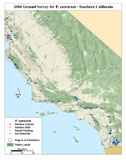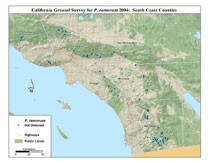On this page you will find a variety of older documents that we have removed from active pages but may still be of interest for historical purposes. They are organized very roughly by content and date but not listed in any particular order – let the treasure hunt begin!
Monitoring
The USDA Forest Service, Pacific Southwest Region, State and Private Forestry, Forest Health Protection program provides a key role in monitoring Sudden Oak Death and Phytophthora ramorum-caused mortality. Below are additional reports, photos, and maps from monitoring efforts around California.
Reports
- National SOD Risk Map Koch, F.H.; Smith, W.D., U.S. Department of Agriculture, Forest Service, Southern Research Station
- P. ramorum risk model summary
- 2006 California National P. ramorum Wildland Survey D. Owen, CDF
- 2006 Accomplishment Report Aerial and Targeted Ground-Based Monitoring for Sudden Oak Death USDA-Forest Service, State and Private Forestry, Pacific Southwest Region
- An Assessment of Sudden Oak Death and Oak Mortality, 2000-2005 USDA-Forest Service, State and Private Forestry, Pacific Southwest Region
- 2005 California National P. ramorum Wildland Survey D. Owen, CDF
- 2004 Aerial Survey J. Mai, L. Fischer, W. Mark, A. Jirka
Landscape Photos
These photos depict Sudden Oak Death areas found in Humboldt County. Click on an image to view the Landscape Photos Library.
 |
 |
 |
Targeted Ground Surveys
Below are early detection surveys conducted of P. ramorum in high risk-forests of California.
- 2004 Targeted Ground Survey R. Meentemeyer and W. Mark
- 2004 California National P. ramorum Wildland Survey D. Owen, CDF
- Monitoring P. ramorum Distribution in Streams within Coastal California Watersheds
Northern California Surveys
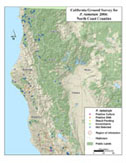 North Coast survey 2004 North Coast survey 2004 |
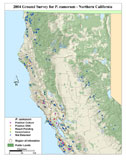 Northern California survey 2004 Northern California survey 2004 |
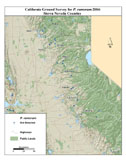 Sierra Nevada survey 2004 Sierra Nevada survey 2004 |
Southern California Surveys
|
|
|
Regulations
Regarding P. ramorum, the stated goal of APHIS-PPQ is to identify the extent of the distribution of P. ramorum in the US, and limit any possible spread beyond the infested area by establishing quarantine areas and by participating in an active public outreach program. As with all of their ISPM (Invasive Species and Pest Management) programs, APHIS is maintaining a website page for Phytophthora ramorum / Sudden Oak Death. The page includes many features, including regulatory and general information on the pathogen, links to other relevant websites, and FAQs. If you navigate to the page listed above, you will find, among others things:
- The full text of Phytophthora ramorum 7 CFR Part 301, which is the interim rule published on 02.14.02 identifying what materials are regulated and how.
- Updates to the interim rule published in July and September of 2002.
- Updates from March/April 2004.
- A FAQ page specific to federal regulatory issues.
- The USDA strategic plan for Phytophthora ramorum, titled: “Plant Diseases Caused by Phytophthora ramorum: A National Strategic Plan for USDA.”
New Regulations February 27, 2007
CDFA P. ramorum Information
California imposed regulations for Phytophthora ramorum in May 2001. The regulations are continually updated to add new hosts and to reflect new scientific understanding.
Within CDFA, the regulation controlling plant movement was prepared by the Pest Exclusion Branch, Plant Health and Pest Prevention Services Division, California Department of Food and Agriculture (CDFA). It is listed in the Plant Quarantine Manual as: State Miscellaneous Ruling 3700 – Oak Mortality Disease Control. The regulation establishes restrictions against P. ramorum and host plants.
State Miscellaneous Ruling 3700 includes, among other things, a description of the pest (P. ramorum), delineation of the regulated area, specific articles and commodities covered, and the restrictions. Appendices include updates to the host list and to the infested areas, sampling guidelines for taking field samples of the pathogen, and the Summary Agency Contact Responsibility. This last item lists in detail which state or federal agency has jurisdiction over which type of land, and under what circumstances.
For the entire text of the initial ruling, click on the following link:http://pi.cdfa.ca.gov/pqm/manual/pdf/455.pdf. Subsequent emergency amendments have added species to the regulated and associated hosts list, and most recently expanded the regulated area to include Lake County. The synopsis of this amendment follows.
Section 3700(b), Oak Mortality Disease Control – Emergency Amendment (for Lake County)
This proposed amendment of the regulation will add Lake County to the regulated area and will establish the restrictions on the handling and movement of regulated articles and commodities and potential carriers of this disease to non-infested counties. The effect of the proposed amendment will be to provide authority for the State to regulate movement of regulated articles and commodities and potential carriers of disease from Lake County to prevent artificial spread of the pest to non-infested areas to protect California’s agricultural industry.For the most current information, go to http://www.cdfa.ca.gov/phpps/pe/InteriorExclusion/SuddenOakDeath/
Nevada Department of Agriculture (Pest Alert 4.8.04)
UK Department for Environment Food and Rural Affairs (DEFRA) – http://www.defra.gov.uk/planth/pramorum.htm
The identification, containment and/or eradication of P. ramorum in plants and plant production in the United Kingdom is the responsibility of various divisions within the Department for Environment Food and Rural Affairs (DEFRA). These include the Plant Health Division (policy and legislative responsibility), the Plant Health and Seeds Inspectorate (enforcement of inspection, surveys, eradication), and the Central Science Laboratory (scientific and technical support).
UK Forestry Commission (FC) – www.forestry.gov.uk/forestry/WCAS-4Z5JLL
The Forestry Commission is responsible for the control and eradication of the pathogen in forest trees and wood. Their work includes research, diagnosis, survey, and scientific consultant. For details on their program, see their website at Forestry Commission.
Summary of Phytopthora ramorum in the UK: Consultation on Future Management of risks of Phytophthora ramorum and Phytophthora kernoviae July 2008
Pest Risk Documentation for the United Kingdom:
Pest Risk Analysis – DEFRA:www.defra.gov.uk/planth/pra.htm
Exotic Pest Alert – FC: http://www.forestry.gov.uk/pdf/EPAversion3.pdf/$FILE/EPAversion3.pdf
Canadian Food Inspection Agency (CFIA) http://www.inspection.gc.ca/english/plaveg/pestrava/phyram/sodmsce.shtml
The Canadian Food Inspection Agency has implemented strict import regulatory controls to prevent the entry of Phytophthora ramorum and Sudden Oak Death disease to Canada on infested goods.
Pest Risk Documentation for Canada:
Pest Fact Sheet – CFIA http://www.inspection.gc.ca/english/plaveg/pestrava/phyram/sodmsce.shtml
Links to the CFIA regulatory information in English are available at: http://www.inspection.gc.ca/english/plaveg/pestrava/phyram/sodmsce.shtml
CFIA’s Plant Health Risk Asessment Unit’s publication: Hosts of Phytophthora ramorum (with notes on grographical distribution and mating types) – Causal Agent of Sudden Oak Death. Full text of document available at: /pdf/P.ramorum.hosts.June.2003.pdf
The CFIA Pest Risk Assessment document is available by contacting the CFIA directly at :Plant Health & Production DivisionCanadian Food Inspection Agency59 Camelot DriveOttawa, OntarioK1A 0Y9
Tel: 613/225-2342Fax:613/228-66011-800/442-2342
The most recent regulatory changes, updates, advisories, and information regarding confirmed and associated host species are below.
December 21, 2004, New Federal Regulations June 23, 2004, Four New Hosts Added June 23, 2004, New Host Added: Camellia spp.May 17, 2004, Additional quarantined countiesApril 29, 2004, New Associated HostApril 23, 2004, Clarification, Amended OrderApril 22, 2004, Amended Order 4 22 2004 April 9, 2004, APHIS PPQ Order 4 9 2004April 7, 2004, Confirmed Nursery ProtocolApril 7, 2004, Confirmed Nursery Protocol SchematicMarch 9, 2004, Pest Alert 1-2004


